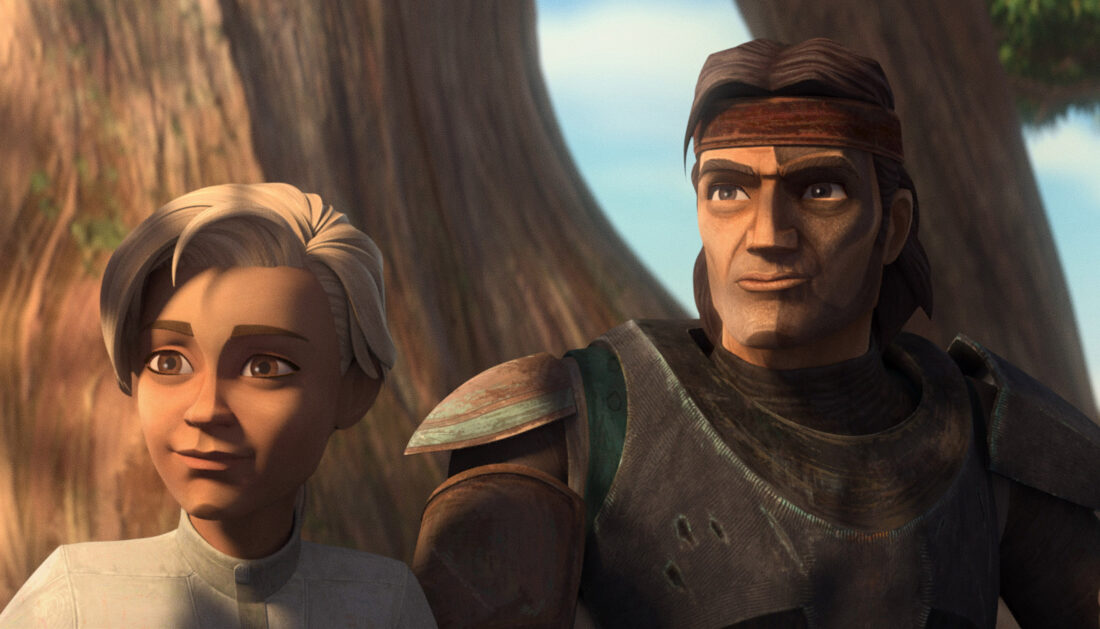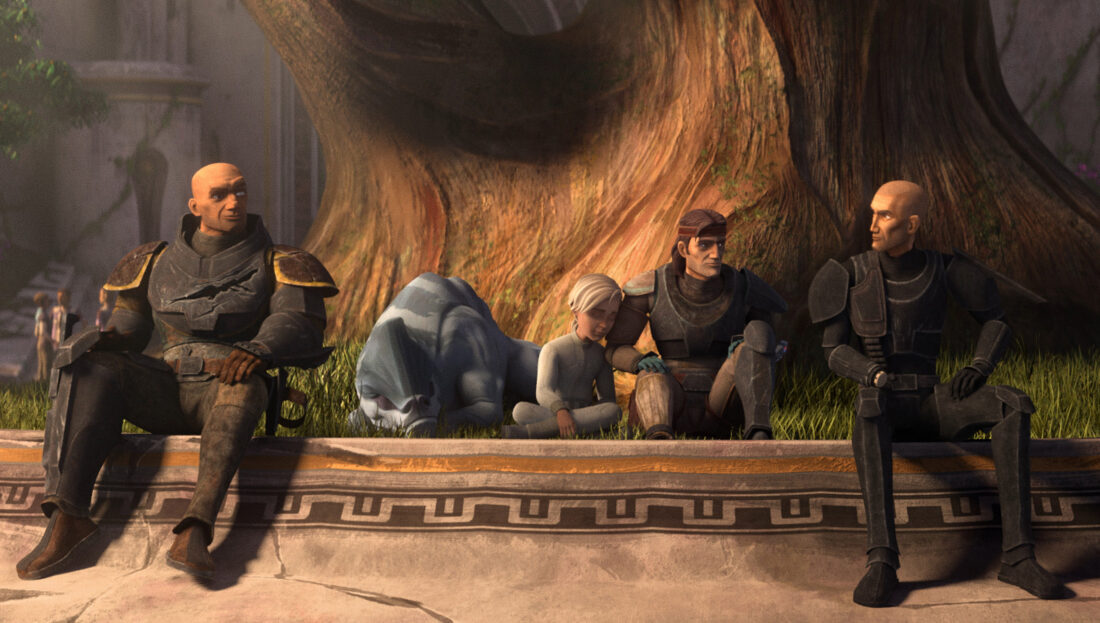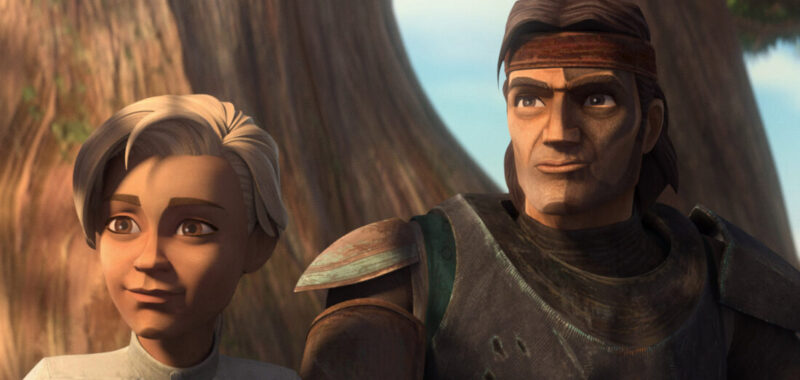With the finale of Star Wars: The Bad Batch there are currently no major animated arcs coming in the Star Wars canon. Which is a shame because since the launching of The Clone Wars series, the animated projects have made up some of the best storytelling that Star Wars has seen in the last twenty years. The Bad Batch easily ranks among them, and the paltry three seasons we received were never going to feel like enough. But, like everything about Clone Force 99, the way that they left was singular and unlikely to be matched.
[Spoilers ahead.]
Season three of Bad Batch is largely devoted to little/big sister Omega coming into her own and getting prodigal… you can’t call him a son, I’m going with prodigal reluctant dad, Crosshair back into the arms of his family. While his inhibitor chip initially prompted Crosshair to walk straight into the arms of the Empire as the fascist organization came into power, by the end of season one, he’d chosen to stay of his own free will, furious over the Batch’s refusal to choose him and join up. Season two showed us what this spiteful decision cost Crosshair as the realization dawned that the Empire would be nothing like the Republic.
It was a key journey to showcase: Crosshair’s mistake was effectively a stand-in for every clone who chose to stay with the Empire. Regardless of their own personal moral leanings (and every clone is different, of course), it makes sense that it would be difficult for many of them to grasp what the Empire truly was at first glance. None of them were designed to question, to learn about the political motivations of war, to buck a lifetime of conditioning and subvert their “purpose.” But after losing someone important to him, Crosshair finally breaks and kills an Imperial officer, getting him sent to a secret base on Tantiss where Omega is also delivered at the end of season two.
Omega bonded to every member of the Batch in her time as their big/little sister slash adopted daughter over the show’s run—she even tried with Crosshair when she met him, fruitless though the attempt seemed. With the setup more blatant than ever on Tantiss (he’s literally stuck in a cell that she walks by on her rounds every day), Omega finally has the opening she needs to do what she does best: Make people better. When she moves to escape the base, she takes Crosshair with her, along with a once-vicious lurca hound that she has named Batcher. Cue awkward family reunion, but more importantly, cue an entire subplot of Crosshair not only returning home to deal with his PTSD, but also getting a therapy dog out of the deal.
The final season tips the possibility that Omega might be Force-sensitive into the pot as well; part of the reason she’s valuable to the Tantiss research facility is that Doctor Hemlock is among the first scientists working on Emperor cloning, and Omega’s high midichlorian count has the potential to make a clone that can wield the Force. But in a wild U-turn away from the Star Wars’ favorite narrative cue—that everything must ultimately center around the Jedi and their powers—The Bad Batch makes the choice to essentially ignore this revelation. Omega gets to meet Asaaj Ventress (who is, thankfully, alive after a rough turn in the novels that suggested otherwise) and try out some training, but there’s no indication in either direction about her potential Force-wielding abilities. And that’s because showrunner Jennifer Corbett and her team seem to rightly understand that it doesn’t matter. Omega’s true abilities lie in her compassion and her ability to encourage others toward that end.

Of course Omega is eventually recaptured (her choice) and of course it means that the Bad Batch have to mount a wild rescue mission that immediately goes sideways. But what’s astounding is that a mission that should have “Total Party Death” written all over it winds up making way for… precisely the opposite.
So let’s get into what that means. Because it’s hard to talk about that finale without the context.
Star Wars stories belong to their name with all the strife that entails, often upbeat in their execution, but far from content for the characters involved. There are very few tales that result in happy endings of any sort—I could count them on one hand. There’s nothing wrong with that choice per se, but it’s also technically a recent change to the mythos; for decades (unless you read the Expanded Universe novels) the central Star Wars story, being the OG trilogy, ended on a high note. As the fictional universe grew, it deprioritized that viewpoint and aligned far more to the prequels side of things, mired in tragedy of a decidedly operatic nature. With all of those stories spinning out to offer a vantage point on the galaxy that is darker than ever, it seems pointed to note that The Bad Batch have joined the ranks of those lucky few characters who get a kinder ending. And the reason that it seems so pointed is precisely because of where they came from and what they lost.
What the animated Star Wars shows built much of their legacy on is attention paid to the clone army, built for the Republic at the secret behest of then-Chancellor Palpatine. That the prequel stories relied upon the presence of a brainwashed slave race who were bought, grown, and trained for the sole purpose of dying for the Republic has been a cornerstone of the narrative since 2002’s Attack of the Clones… but the prequels weren’t built to tell that part of the story. Animation was well-suited to the task of shining a light on the humanity of the clone troopers; after all, it’s easier to animate thousands of identical men than it is to CGI composite thousands of performances from one actor. And so the animated shows became the place to showcase just that, and the clone army was given a space where they could be presented as people rather than identical cannon fodder.
That choice led to some of the best stories Star Wars has told. But it also created a vicious little conundrum: The characters that many viewers counted among their favorites never had a shot at a real life. They were forced to be soldiers in a war they had no part in causing, for the side that paid for their birth and programming. They were created to serve and then to die.
While it didn’t come clear until the end, The Bad Batch turned out to be a story about a few of those clones getting a chance to choose their own futures. Corbett and crew took that opportunity to narrow focus in on the clones’ experience and bolted with it, seemingly straight for the finish line without ever once looking back. And in many ways, it used tragedy toward a far more meaningful coda than Star Wars often offers.
And that’s all because of Tech.
Having assumed a much harsher ending was coming for these characters, I was dismayed—both as a critic and as a fan—at Tech’s death in the end of season two. It was beautifully written, but it felt like either a probable warmup to greater loss, or a possible fakeout, which Star Wars has pulled too many times. (“Somehow, Palpatine returned” is likely to get etched on J.J. Abrams’ grave at this rate.) The point was that I doubted the death would continue to be meaningful in retrospect, which is unfortunately a common problem in fiction today. We’ve gone so far in the direction of death for the sake of shock or realism that it has actually ceased to have narrative weight in most cases.
But the Bad Batch all survive this fight. Every last one of them. And they go back to Pabu and live safe, completely outside their function and programming as soldiers. And Omega gets to grow up with the people she loves surrounding her and guiding her. And suddenly, Tech’s death isn’t just a precursor to more terrible misfortune in an unfair universe—it was for this. His family living on a world that he loved, figuring out who they are outside of that armor and spending time doing whatever moves them. Omega getting the childhood that Phee pointed out she was missing. Clone Force 99 growing old together.

Yes, Omega leaves home in the end to join the Rebellion, but that’s just where growing up leads. (He’d be proud of her, in any case.) And yes, something needs to be said about the many clones who died in service of them getting that ending. (Star Wars needs to have a talk with itself about how it renders collateral damage, but that is truly another conversation for another time.) And yes, there is always the chance that someone will come along and undo the whole thing with a later tale.
But for now, Tech’s final words are the perfect punctuation at the end of their story: “When have we ever followed orders?”
Never. And look how that paid off for them? Perhaps it’s time for a few more characters in that galaxy far, far away to sit up and take note.

